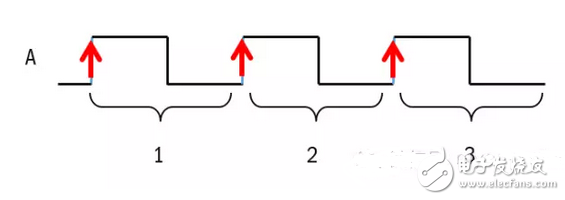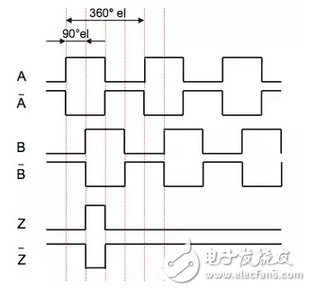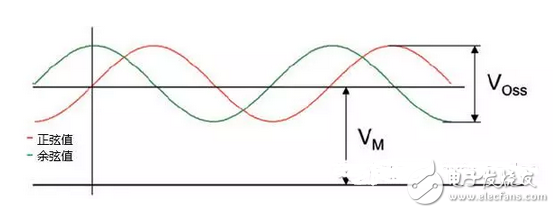Before introducing the sine and cosine encoder, let's review a lower wave incremental encoder.
The output of the square wave incremental encoder is an orthogonal AB pulse signal, that is, a high level or a low level. We call the change from low to high as a rising edge. The output of the encoder is a periodic repetition from one rising edge to another rising edge. The resolution of the encoder is in one-to-one correspondence with the reticle of the code wheel. Such an AB signal is periodically repeated a plurality of times during the rotation of the encoder. If the encoder is 1024 encoders, the encoder will rotate lap and there will be 1024 such signal cycle outputs. According to this, the resolution of the encoder is 1024 lines, or 1024 pulses. It is the number of signal cycles output by the encoder per revolution.

In order to increase the resolution of the incremental encoder, sometimes four times the frequency is used, that is, while calculating the rising edge, the falling edge is also calculated, so that each period can be subdivided into four steps.

In addition to the AB pulse signal, there is also a reference mark that is important for determining the position, that is, a reference signal or a zero mark. Usually the zero mark appears only once in a circle to indicate the origin of the encoder. In other words, the incremental encoder can only determine an absolute position within one revolution.
In order to further increase the resolution of the encoder, it is necessary to increase the density of the code disc reticle. However, the resolution of a square wave incremental encoder is subject to two constraints. On the one hand, the size of the code disc is limited. 60mm outer diameter encoder, the physical engraving line generally does not exceed 10,000 lines. On the other hand, the output frequency is proportional to the encoder's speed and resolution. Higher resolution means higher output frequencies, while high frequencies do not allow long-distance transmission.

The sine and cosine encoder is similar to the AB quadrature pulse signal of a common square wave incremental encoder. The difference is that the sinusoidal encoder outputs sine and cosine signals with peak-to-peak value of 1V or 2V through the A and B channels. When the encoder rotates one turn, it also periodically generates multiple sine and cosine cycles, such as 512 (29), 1204 (210) or 2048 (211).

Although the number of sine and cosine cycles (physical resolution) does not look very high, in the controller or driver, through the encoder input circuit processing and calculation, each sine and cosine cycle can be subdivided into many by the inverse tangent interpolation operation. Steps to achieve high resolution.
X = Arctan(Sin(X)/Cos(X))
Based on the real-time amplitude of the sine and cosine signals, the exact position (electrical angle) of the encoder at this moment within this sine and cosine period can be determined by Arctan calculation. Depending on the resolution of the analog AD conversion and the quality of the sine and cosine signals, each sine and cosine cycle can typically be subdivided into steps 212 through 214. The number of sine and cosine cycles per revolution of the encoder itself, multiplied by the number of subdivision steps of each sine and cosine cycle, constitutes the total resolution per lap of the sine and cosine encoder.
Total resolution per revolution after subdivision = number of cycles per revolution X number of subdivisions per cycle
For example, a sine-cosine encoder with 1024 cycles per revolution has a total resolution of 13 bits subdivided: 210 x 213 = 210 + 13 = 223
It is worth noting that the resolution after subdivision is calculated by the controller or driver through the input circuit processing, and is not directly output by the encoder.
Refrigerator Condenser Evaporator
1. Main material:
Rolling welded steel pipe: OD 4.76 to 8
Wall thickness:0.5- 0.7
Low carbon steel wire OD 1.0 to 1.8
Bracket:
Steel plate (SPCC) thickness: 0.6 to 1.5
Steel plate (SPCC) thickness: 0.3 to 0.4
2.Structure:
Flat type of Wire On Tube Condenser used at the back
Bended or spiral type of wire on tube condenser used at the bottom
Wrapped type of tube embedded on plate
3.Technical ability:
Wire pitch: ≥ 5mm
4.Performance:
Surface with electrophoresis coating to prevent the corrosion
Inner cleanliness can meet the requirements of CFC and R134a cooling system
Can satisfy the cooling capability requirements
Condenser Evaporator,Evaporator And Condenser,Refrigerator Evaporator,Compressor Condenser Evaporator
FOSHAN SHUNDE JUNSHENG ELECTRICAL APPLIANCES CO.,LTD. , https://www.junshengcondenser.com